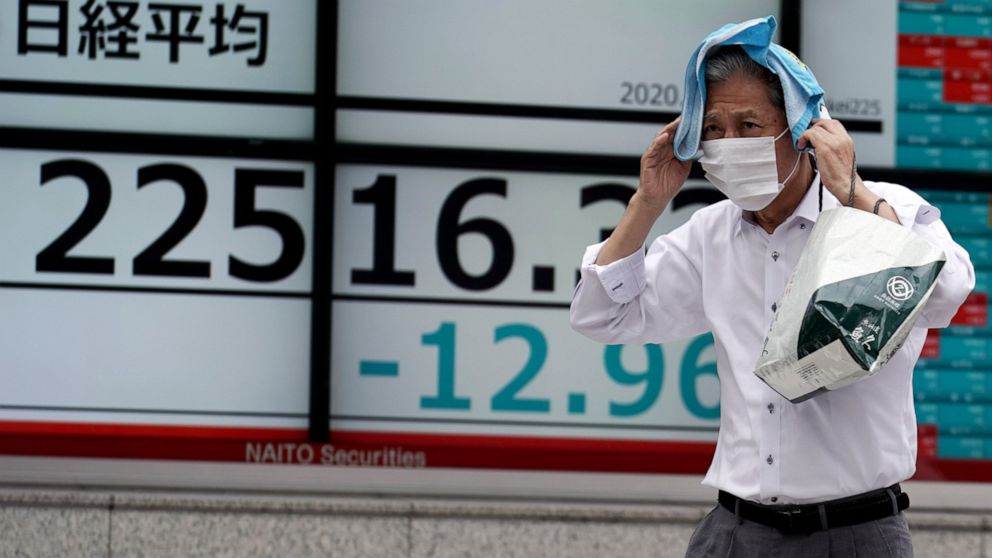Wall Street rises as optimism caps erratic week of trading
Wall Street is pushing higher Friday, and the S&P 500 is heading for its third weekly gain in the last four
By
STAN CHOE and DAMIAN J. TROISE AP Business Writers
July 10, 2020, 6:05 PM
4 min read
NEW YORK — Wall Street is pushing higher Friday, and the S&P 500 is heading for its third weekly gain in the last four.
The S&P 500 was 0.5% higher, as of 1:30 p.m. Eastern time, with the biggest gains coming from cruise operators, airlines, banks and other companies that most need the economy to reopen and strengthen.
The Dow Jones Industrial Average was up 198 points, or 0.8%, at 25,904, while the Nasdaq composite edged up 0.2% to add more to its record close from Thursday.
The market’s gains were broad, after Wall Street shook off a wobbly start to the day’s trading. The Russell 2000 index of small-cap stocks was up a solid 1.2%, and Treasury yields erased earlier losses to climb in afternoon trading.
They’re the latest eddies in what’s been an erratic week for markets. Prices have swung, sometimes sharply within a single day, as worsening coronavirus infection counts across the U.S. Sun Belt and other global hotspots raise concerns that the recent improvements in the economy may be set to stall.
The week’s meandering action was a microcosm of the up-and-down churn that stocks have been stuck in for a little more than a month. The market’s momentum has stalled since early June, after the S&P 500 roared back to recover most of an earlier 34% plummet.
Massive amounts of aid from central banks and governments around the world ignited the rally, which later built higher on hopes for a coming economic recovery. But rising coronavirus infection levels in Florida and other big states are threatening to derail the budding recovery.
“We are dealing with an unprecedented time economically,” said Katerina Simonetti, senior portfolio manager at UBS Private Wealth Management. “We have to remember that the government support and economic stimulus has been historically unprecedented. That’s a huge deal, and it’s going to make a difference for this market.”
A report on Friday showed that prices at the wholesale level fell last month from May, a weaker reading than the rise that economists were expecting. It’s a signal of how weakened activity throughout the economy is keeping a lid on inflation.
But stocks of companies that most need the economy to continue improving and reopening were taking the lead Friday. Helping to lift the market was a 2% gain for Gilead Sciences, which said its investigative treatment for COVID-19, remdesivir, helped reduce the risk of mortality in patients.
Cruise operator Carnival gained 8.9%, and United Airlines rose 7.3%.
Banks were also particularly strong, with financial stocks in the S&P 500 up 2.9%. A stronger economy would mean their borrowers are better able to repay their loans.
Energy stocks climbed with the price of oil, which has swung sharply with hopes for the economy. Benchmark U.S. crude oil rose 2% to $40.42 per barrel. Brent crude, the international standard, added 1.5% to $43.00.
Lagging behind the rest of the market were some of the stocks that have been holding up best this year: big tech-oriented giants. Apple slipped 0.3%, and Microsoft dipped 0.5%. It’s at least a temporary pause for such stocks, which have climbed through the pandemic this year as investors bet they’ll be able to keep growing almost regardless of the economy’s strength.
Because these tech giants are so big — just five of them make up 23% of the S&P 500’s market value — their movements have outsized sway on market indexes. That helped restrain the S&P 500, even though roughly seven in 10 stocks for index were higher.
The yield on the 10-year Treasury, which tends to move with investors’ expectations for the economy and inflation, rose to 0.62% from 0.60% late Thursday.
In overseas stock markets, European markets edged up after official figures showed industrial production bounced back sharply in some countries.
Manufacturing jumped 22% month-on-month in France in May, making up for the previous month’s fall. In Italy industrial production spiked 42% during the same month.
The CAC 40 in France added 1%, while Germany’s DAX returned 1.2%. The FTSE 100 in London gained 0.8%.
In Asia, the Nikkei 225 in Tokyo shed 1.1%, the Hang Seng in Hong Kong retreated 1.8% to 25,727.41 and the Kospi in Seoul lost 0.8%.
Even Chinese stocks took a break from their torrid run. Stocks in Shanghai slumped nearly 2% for their first drop in nearly two weeks. They’re still up 14.3% over that span.
![]()


